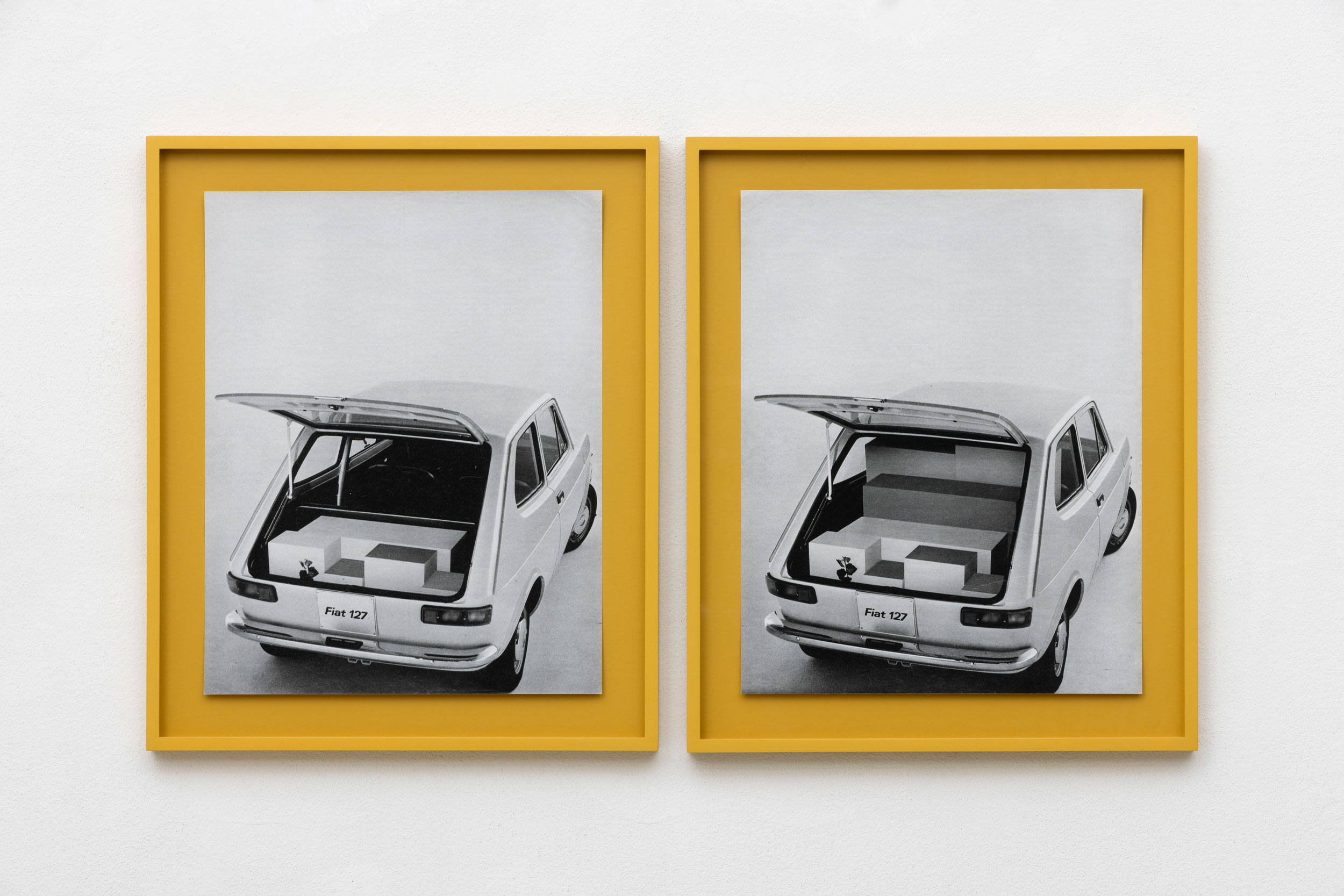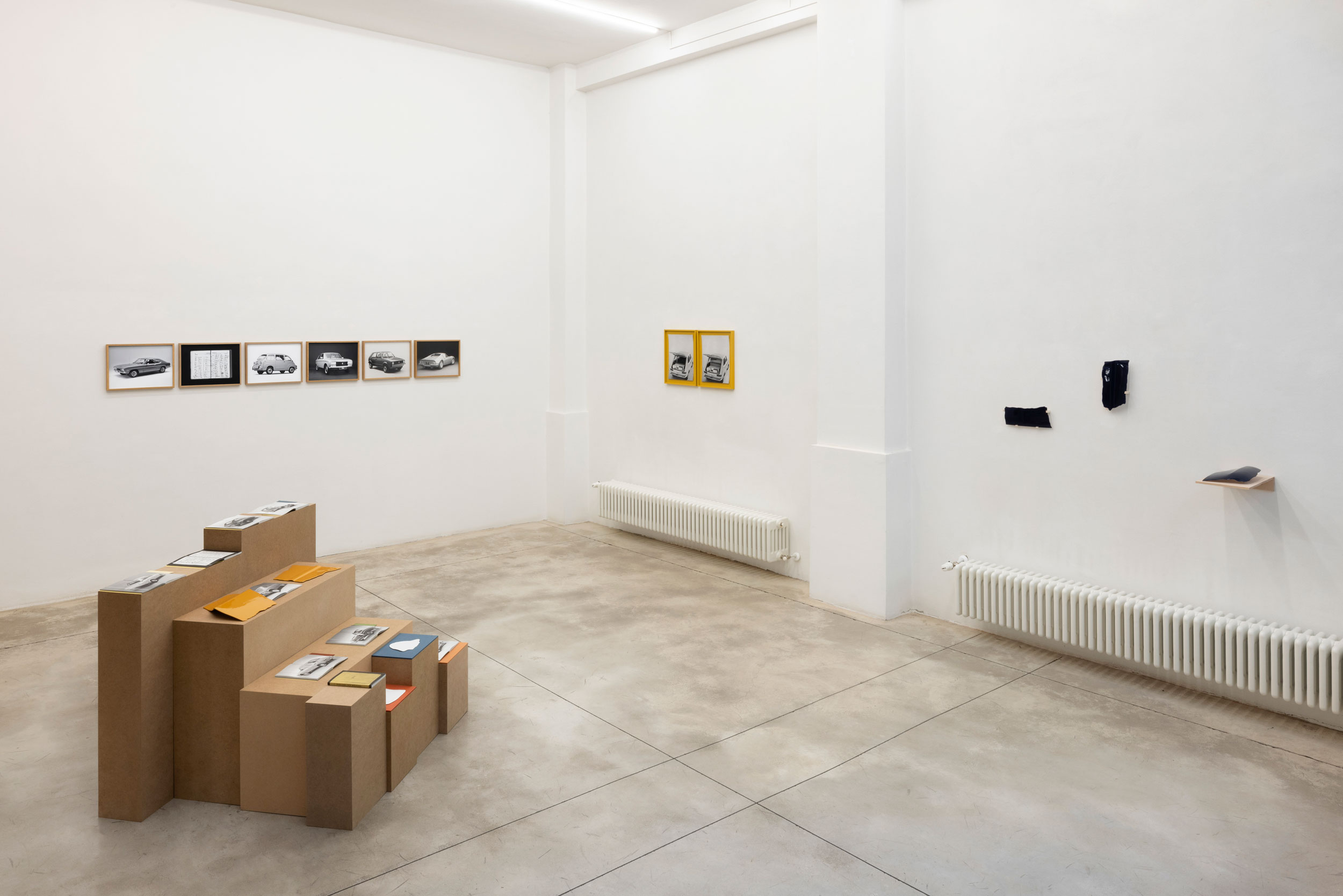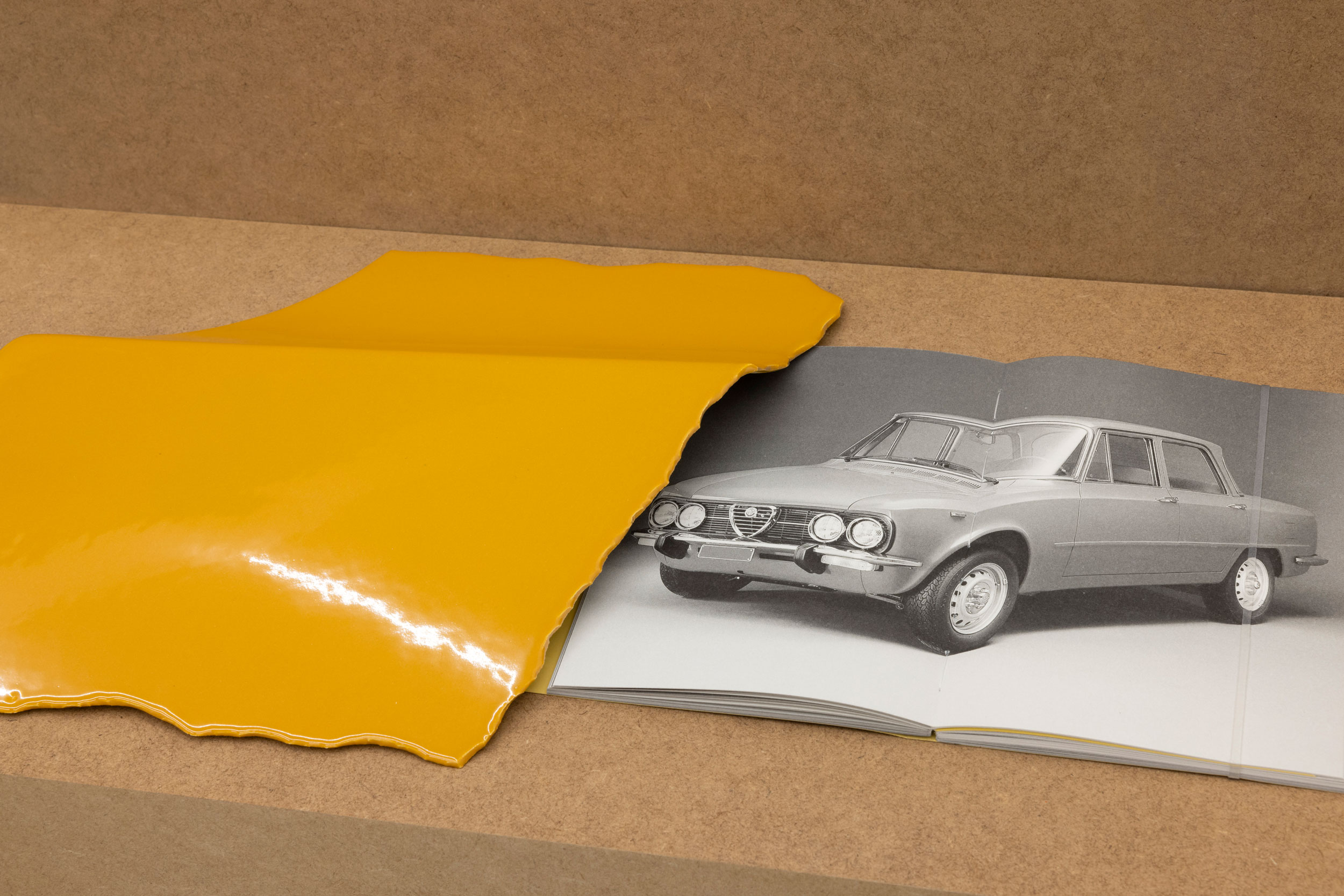Tutto lamiera
Daniela Comani, Federico Maddalozzo
with a text contribution of Ivan Carozzi
Cler, Milano
December 12, 2023 - February 15, 2024
Press release
"Citroën DS is always there waiting. Only what does not have a soul, like the automobile, does not betray." I.C.
Originally, the spaces of our studio at via Padova 27 housed a mechanical workshop, and even earlier, a postal station for changing horses for those traveling to or out of Milan. For a long time, our courtyard was the place to rest before continuing the journey. When we first entered in 2016, a poster of a blue Ford GT 40 from the 1960s hung on the wall, the space was buried under rubble, and instead of the entrance door, a piece of blue PVC tarpaulin dangled.
David Cronenberg believes that working on a car engine is an almost philosophical experience. You don't just see the design and technology, but above all, the rationality and mind of the one who designed it. It's immediately evident that it's the creation of a human being, almost a photograph of recent human history.
As a child, Daniela Comani kept a travel diary, jotting down every detail of the cars she saw from the window during long holiday trips. When, many years later, the diary resurfaced from some box, she found herself holding a document of collective memory, because cars are also this.
Federico Maddalozzo's ceramic sculptures are torn shreds from a larger body. Observing them, you get the feeling that they are anything but rubble or scraps, but rather functional components that have not yet finished their work. As if at any moment they could reassemble into the mother body, perhaps with a different function than before. A work, albeit so plastic, more tied to time rather than space. These shreds of metal skin are there to remind us that the arc of existence is no longer tied to a beginning and an end as much as it is to transformation.
Thinking about cars and their shiny skin, we remembered some readings from the past. One dealt with "memory" industrial sheets, sheets containing two small opposing springs inside, one serving to cushion the blow, the other, solicited at a certain temperature, activates by exerting pressure on the first spring to restore the damaged sheet to its original shape. Rather bizarrely, this made us think of a study by neuroscientists demonstrating how memory is not something the brain retrieves from a hidden drawer, but is the result of neuronal activation that prevents the memory itself from being immune from the moment it is activated. In simple terms: memory (and how we relive it) cannot be separated from the personal historical moment in which it resurfaces, much less from the experiences lived in the meantime, from the emotions and feelings we experience at that precise period.
The "memory pieces" of Daniela Comani and Federico Maddalozzo come together in our studio in via Padova, where a new and unprecedented collective memory is starting to build itself today. Where most of the people who inhabit it are themselves fragments of memory that do not yet belong to us, because they come from afar. Like memories.
Accompanying the exhibition "Tutto Lamiera" there will be a special edition with a shared image of Daniela Comani and Federico Maddalozzo and a text by Ivan Carozzi written for the occasion assembling sheets of his Milanese daily life.

Daniela Comani & Federico Maddalozzo
“Fiat 127 / Giallo 251”
archival pigment print on PhotoRag, framed: 45 x 38 x 3 cm with color intervention on frame.

Volume di carico
2023, MDF, Valchromat, ceramic, plaster, artist book by Daniela Comani ‘1975 - Diario di strada’, NCS color samples. 122 x 95 x 100 cm




Volume di carico
2023, MDF, Valchromat, ceramic, plaster, NCS color samples
122 x 95 x 100 cm
Publication:
artist book by Daniela Comani ‘1975 - Diario di strada’
Archive Books, Berlin. 2017 ISBN 978-3-943620-66-5





LAVATER
Quando passo per corso Magenta, ogni volta ripenso a un pomeriggio di molti anni fa. Camminavo in direzione di piazzale Baracca e all'improvviso, come se fossi non più a Milano ma ad Austin o a Dallas, vidi due enormi automobili americane degli anni Ottanta, due bolidi praticamente nuovi, uno di un verde menta brillante, l’altro di uno sfolgorante color oro. Erano due auto dello stesso modello, parcheggiate l’una accanto all’altra lungo il marciapiede. Erano rilucenti come una coppia di star della country music pronta a salire sul palco. Ogni volta che passo in via Pirelli, sotto il grattacelo Pirelli, ricordo una notte dello scorso inverno. Erano circa le tre e ho notato qualcosa che non tornava nella sagoma di un suv nero. La strada era deserta e il suv era parcheggiato accanto a tante altre macchine parcheggiate, con la differenza che la portiera davanti, sul lato del passeggero, era leggermente aperta.Anche se avevo paura, mi sono avvicinato e ho provato a guardare dentro. Non ho toccato nulla, ho solo infilato la faccia dentro la macchina. Sembrava tutto a posto, non c’era nulla che lasciasse pensare a un furto o a uno scasso, eppure la portiera era aperta, come se qualcuno avesse dimenticato di chiuderla del tutto. Ho avuto paura, me ne sono andato e per un po' ho avuto il timore che qualcuno mi stesse seguendo. Lungo via Pacini vedo sempre un vecchio maggiolone Volkswagen celeste. È veramente vecchio e decrepito. Guardo le protuberanze sul parafango e la ruggine marrone sul paraurti. Sembrano creste montane viste dall’alto. Sono andato spesso a fotografare il Volkswagen celeste. L’ho fotografato da diverse posizioni, ma non sono mai riuscito a rivedere nella foto ciò che vedevo nella realtà. Una volta ho lasciato un biglietto sul tergicristallo per poter parlare con i proprietari. Un’altra volta ho fatto qualche domanda al titolare del bar di fronte. Dalle informazioni che ho raccolto, credo di aver capito dove abitano i due proprietari. Pare siano una coppia di anziani marito e moglie. Non ho altre informazioni. Ho il sospetto che abbiano una casa da qualche parte in campagna, perché spesso ho notato qua e là dei residui di fango e piccoli fili d'erba, sia sul predellino, che sulle gomme e il tergicristallo. Per un anno ho fotografato tutti i maggioloni che mi capitava d’incontrare per strada o di salvare la schermata del computer tutte le volte che un maggiolone compariva in un film o in una foto. Ho collezionato decine d’immagini di maggioloni. In Bovisa ho visto un camper con un altare dedicato all’Inter. In via Benedetto Marcello vedo spesso un furgone malandato e tutto ricoperto di scritte a spray. Probabilmente apparteneva a un raver.Al posto della serratura c'è un lucchetto che tiene agganciata la portiera con il portellone laterale. Un giorno ho provato a guardare dentro il vano anteriore ed era tutto pieno di spazzatura. Era una specie di discarica. Ce ne sono diversi a Milano, in particolare tra Romolo e i Navigli. Molti fiorai bengalesi possiedono dei vecchi furgoni Ford Transit pieni di scritte. Li tengono parcheggiati accanto al chiosco. Forse sono furgoni che hanno comprato dai raver o forse i fiorai li parcheggiano in zone periferiche e così, di notte, arrivano i writer e li ricoprono di scritte.A volte vado in piazzale Lavater. Al pianoterra di un palazzo c'è l'ingresso con la sbarra di un'autorimessa. Si chiama Garage Silens”. Accanto all’ingresso c'è una vetrina impolverata, dove qualcuno ha sistemato una Citroën DS degli anni Sessanta, con dentro una copia de L'Humanité”. Mi avvicino al vetro e oltre il grigio e le chiazze osservo la macchina come se fosse una venere, nuda e supina che mi guarda da dentro la cabina di un peep show. La Citroën DS è sempre lì che aspetta. Solo ciò che non ha un'anima, come l'automobile, non tradisce.
Ivan Carozzi
Quando passo per corso Magenta, ogni volta ripenso a un pomeriggio di molti anni fa. Camminavo in direzione di piazzale Baracca e all'improvviso, come se fossi non più a Milano ma ad Austin o a Dallas, vidi due enormi automobili americane degli anni Ottanta, due bolidi praticamente nuovi, uno di un verde menta brillante, l’altro di uno sfolgorante color oro. Erano due auto dello stesso modello, parcheggiate l’una accanto all’altra lungo il marciapiede. Erano rilucenti come una coppia di star della country music pronta a salire sul palco. Ogni volta che passo in via Pirelli, sotto il grattacelo Pirelli, ricordo una notte dello scorso inverno. Erano circa le tre e ho notato qualcosa che non tornava nella sagoma di un suv nero. La strada era deserta e il suv era parcheggiato accanto a tante altre macchine parcheggiate, con la differenza che la portiera davanti, sul lato del passeggero, era leggermente aperta.Anche se avevo paura, mi sono avvicinato e ho provato a guardare dentro. Non ho toccato nulla, ho solo infilato la faccia dentro la macchina. Sembrava tutto a posto, non c’era nulla che lasciasse pensare a un furto o a uno scasso, eppure la portiera era aperta, come se qualcuno avesse dimenticato di chiuderla del tutto. Ho avuto paura, me ne sono andato e per un po' ho avuto il timore che qualcuno mi stesse seguendo. Lungo via Pacini vedo sempre un vecchio maggiolone Volkswagen celeste. È veramente vecchio e decrepito. Guardo le protuberanze sul parafango e la ruggine marrone sul paraurti. Sembrano creste montane viste dall’alto. Sono andato spesso a fotografare il Volkswagen celeste. L’ho fotografato da diverse posizioni, ma non sono mai riuscito a rivedere nella foto ciò che vedevo nella realtà. Una volta ho lasciato un biglietto sul tergicristallo per poter parlare con i proprietari. Un’altra volta ho fatto qualche domanda al titolare del bar di fronte. Dalle informazioni che ho raccolto, credo di aver capito dove abitano i due proprietari. Pare siano una coppia di anziani marito e moglie. Non ho altre informazioni. Ho il sospetto che abbiano una casa da qualche parte in campagna, perché spesso ho notato qua e là dei residui di fango e piccoli fili d'erba, sia sul predellino, che sulle gomme e il tergicristallo. Per un anno ho fotografato tutti i maggioloni che mi capitava d’incontrare per strada o di salvare la schermata del computer tutte le volte che un maggiolone compariva in un film o in una foto. Ho collezionato decine d’immagini di maggioloni. In Bovisa ho visto un camper con un altare dedicato all’Inter. In via Benedetto Marcello vedo spesso un furgone malandato e tutto ricoperto di scritte a spray. Probabilmente apparteneva a un raver.Al posto della serratura c'è un lucchetto che tiene agganciata la portiera con il portellone laterale. Un giorno ho provato a guardare dentro il vano anteriore ed era tutto pieno di spazzatura. Era una specie di discarica. Ce ne sono diversi a Milano, in particolare tra Romolo e i Navigli. Molti fiorai bengalesi possiedono dei vecchi furgoni Ford Transit pieni di scritte. Li tengono parcheggiati accanto al chiosco. Forse sono furgoni che hanno comprato dai raver o forse i fiorai li parcheggiano in zone periferiche e così, di notte, arrivano i writer e li ricoprono di scritte.A volte vado in piazzale Lavater. Al pianoterra di un palazzo c'è l'ingresso con la sbarra di un'autorimessa. Si chiama Garage Silens”. Accanto all’ingresso c'è una vetrina impolverata, dove qualcuno ha sistemato una Citroën DS degli anni Sessanta, con dentro una copia de L'Humanité”. Mi avvicino al vetro e oltre il grigio e le chiazze osservo la macchina come se fosse una venere, nuda e supina che mi guarda da dentro la cabina di un peep show. La Citroën DS è sempre lì che aspetta. Solo ciò che non ha un'anima, come l'automobile, non tradisce.
Ivan Carozzi